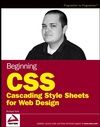From the Back Cover
Cascading Style Sheets (CSS) is a standard for Web site presentation that allows Web developers to define styles for all the visual aspects of a Web document. This example-packed book provides you with necessary information that will enable you to combine CSS with HTML, XHTML, or XML to create rich, aesthetically powerful designs.
You'll start by reviewing the background of CSS, followed by a discussion of the tools required to create and test Web pages, a look at the basic syntax used in CSS, and an examination of how CSS comes together with markup to create a Web page. Then you'll examine how CSS controls different aspects of markup in a Web document. Along the way, you'll end each chapter with exercises and sample solutions that will help you grasp the CSS level 1, 2, 2.1, and 3 specifications.
What you will learn from this book
- How to choose the right document for a project
- Why the Document Type Declaration (DTD) is important to the CSS designer
- Ways to manipulate the presentation of fonts
- Ways to manipulate text and fonts
- The four different types of positioning: static, relative, absolute, and fixed
- Various ways of styling for tables, XML, print, and handheld devices
- Techniques to make a CSS design compatible with Internet Explorer
Who this book is for This book is for beginning Web developers and designers who want to use CSS for better, faster design and markup. Basic familiarity with HTML is helpful, but not required.
Index
Acknowledgments.
Introduction.
Chapter 1: Introducing Cascading Style Sheets.
Chapter 2: Document Standards.
Chapter 3: The Basics of CSS Anatomy and Syntax.
Chapter 4: Data Types, Keywords, Color, Length, and the URI.
Chapter 5: CSS Selectors.
Chapter 6: Pseudo-Element and Pseudo-Class Selectors.
Chapter 7: Inheritance and the Cascade.
Chapter 8: Text Manipulation.
Chapter 9: Font Manipulation.
Chapter 10: Liquid Design and the CSS Box Model.
Chapter 11: CSS Buoyancy: Collapsing Margins, Floating, and Vertical Alignment.
Chapter 12: Styling Lists and the User Interface.
Chapter 13: Backgrounds: Setting the Scene.
Chapter 14: Positioning.
Chapter 15: Styling for Handheld Devices and Print.
Chapter 16: Styling Tables.
Chapter 17: Styling XML.
Chapter 18: Cross-Browser Compatibility.
Appendix A: Exercise Answers.
Appendix B: CSS Reference.
Appendix C: CSS Colors.
Appendix D: Browser Rendering Modes.
Index.

Comments
Be the first to write a comment
You must me logged in to write a comment.